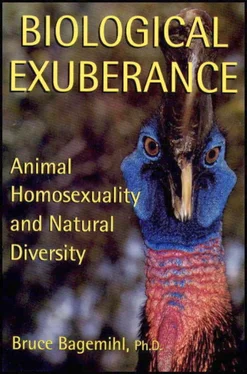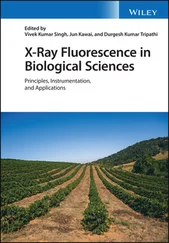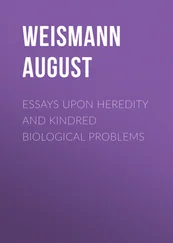Homophobia in the field of zoology is not always this overt or virulent; nevertheless, ignorance or negative attitudes that are not directly expressed usually have identifiable consequences and important ramifications for the way the subject is handled. Discussion of animal homosexuality has in fact been compromised and stifled in the scientific discourse in four principal ways: presumption of heterosexuality, terminological denials of homosexual activity, inadequate or inconsistent coverage, and omission or suppression of information.
Heterosexual Until Proven Guilty
…after about twenty minutes I realized that what I was watching was three whales involved in most erotic activities!… Then one, two, and eventually three penes appeared as the three whales rolled at the same time. Obviously, all three were males! It was almost two hours after the first sighting… and up to that point I was convinced I was watching mating behavior. A discovery—and a stern reminder that first impressions are deceiving.
—JAMES DARLING, “The Vancouver Island Gray Whales” 26
Many behavioral studies of animals operate under a presumption of heterosexuality: a widespread—if not universal—assumption among field biologists is that all courtship and mating activity is heterosexual unless proven otherwise. This is particularly prevalent in studies of animals in which males and females are not visually distinguishable at a distance. The scientific literature is filled with examples of biologists who were convinced that the sexual, courtship, or pair-bonding activity they had been observing was between a male and female—until confronted with clear evidence of homosexuality, such as a glimpse of two sets of male genitalia, or a nest containing more eggs than just one female could have laid. 27
Two male Gray Whales participating in homosexual activity off the coast of Vancouver Island. Only the erect penises of the whales are visible above the surface of the water, but this enabled scientists to verify the sex of the animals. Without this confirmation, observers would probably have mistaken this for heterosexual mating activity.

Moreover, many zoologists still routinely determine the sex of animals in the field based on their behavior during sexual activity—with the (often unstated) assumption that there must be both a male (the one doing the mounting) and a female (the one being mounted) in any such interaction. Of course, this automatically eliminates any “chance” of observing homosexual activity in the first place. A field study of Laughing Gulls, for example, utilized the following assumptions in determining the sex of birds: “(1) any bird copulating more than twice on top was presumed a male, and (2) the mate of a male was presumed to be a female.” Yet other studies of this species in both the wild and captivity have revealed that male homosexual mounting and pairing do in fact occur in Laughing Gulls. Scientists studying sexual behavior in Common Murres admitted that they probably underestimated the frequency of homosexual mounting because they assumed that sexual activity involved opposite-sex partners unless they had direct evidence to the contrary. Amazingly, this practice is even used in species where homosexual behavior is known to occur from previous studies of either captive or wild animals, such as Kittiwakes and Griffon Vultures. 28True, some biologists have critiqued this method of sex determination—but only on the grounds that it can miss examples of reverse heterosexual mounting (where females mount males). 29And in spite of its obvious shortcomings, behavioral sex determination continues to be employed in recent studies, some of which constitute the first and only documentation of little-known species. One can only guess at how many examples of homosexual activity have been and will continue to be overlooked because of this. 30
Even in captivity, the sex of animals is often mistaken, and the consequent “amending” of mating or courtship activity from heterosexual to homosexual sometimes results in elaborate retractions, revisions, and reinterpretations. Renowned German ornithologist Oskar Heinroth, for example, published one of the first descriptions of heterosexual mating in Emus—only to discover that the two birds he had been observing in captivity were in fact both males, prompting him to publish a “correction” to his earlier description three years later. In reviewing the earliest descriptions of courtship behavior in captive Regent Bowerbirds, scientists realized that what had previously been described as heterosexual activity was in fact display behavior performed between two males. This resulted in rather confusing citations of the earlier material such as the following, in which the true sex of the birds is indicated by the later author’s bracketed insertions (prefaced by the assertion “I make no apology for revising in brackets his text to make it meaningful”): “‘These love-parlours, each one built by a female [immature male] for her [his] sole use… were of the shape of a horseshoe…. The female would enter and squat in her [in the immature male’s] love-parlour, the tail remaining towards the entrance… the rejected females [immature males in adult female dress]… built or partly built three love-parlours in different spots.‘” The very first description of “heterosexual” courtship and mating in Dugongs (a marine mammal) was published, ironically, in a scientific article prefaced with lines of romantic verse about the “heaving bosoms” of mermaids and sea nymphs (creatures that the animal has historically been mistaken for). Ironic, because nearly a decade later biologists confirmed that both animals involved in this sexual activity were actually males. 31
Perhaps the most convoluted—and humorous—mix-up of this sort involves a set of King Penguins that were studied at the Edinburgh Zoo from 1915 to 1930. The various permutations and shufflings of mistaken gender identities (on the part of human observers, not the birds) reached truly Shakespearean complexity. The sex of the penguins was initially determined on the basis of what was thought to be heterosexual behavior, and the birds were given (human) names accordingly. Following this, however, some “puzzling” observations of apparently homosexual activity were made. Subsequent re-pairings and breeding activity eventually revealed—more than seven years later!—that in fact the sex of all but one of the birds had been misidentified by the scientists. At this point a comprehensive “sex change” in the names of the birds was hastily instituted to reflect their true genders: “Andrew” was renamed Ann, “Bertha” turned into Bertrand, “Caroline” became Charles, and “Eric” metamorphosed into Erica (“Dora” had correctly been identified as a female). Ironically, although some previous “homosexual” interactions could be reclassified as heterosexual once the true sex of the birds was known, other less straightforward revisions were also required. Two penguins that had initially been seen engaging in “heterosexual” activity—“Eric” and Dora—later turned out to be same-sexed, while premature observations of lesbian mating between “Bertha” and “Caroline” were confirmed as homosexual—but actually involved the males Bertrand and Charles! 32
Sometimes the presumption of heterosexuality concerns not the sex of animals but the context in which courtship or pairing activity occurs. This can be characterized as a “heterocentric” view of animal behavior, i.e., one that tends to see all forms of social interaction as revolving around heterosexual activity (see chapter 5). For example, female homosexual pairs in a number of birds, such as Snow Geese, Ring-billed Gulls, Red-backed Shrikes, and Blue Tits, were initially thought to represent the female portion of heterosexual trios. The females were erroneously assumed to be bonded not to each other but to a third, male, bird (that had yet to be observed)—to the extent that several researchers felt compelled to provide explicit evidence and argumentation that no male was associated with such female pairs. Likewise, courtship and mounting activity between male Guianan Cock-of-the-Rock was categorized as a form of “disruption” of heterosexual courtships in one study, when in fact the majority of same-sex activity took place outside of heterosexual courtships when females weren’t even around. In a similar vein, same-sex behavior in Stumptail Macaques was classified as sexual in one study only if it occurred “during or immediately after or between heterosexual copulations.” In summarizing the pairing strategies adopted by widowed Jackdaws, one scientist enumerated only heterosexual mating patterns and failed to include the formation of female homosexual pairs, even though his own data showed that 10 percent of widowed females attracted new female mates. Likewise, one author’s discussion of homosexual activity in male Cheetahs focused on a single case where males mounted each other in apparent “frustration” during heterosexual courtship activities, when in fact the majority of same-sex interactions did not occur in this type of context. Finally, sexual activity and bonding between female Bonobos has traditionally been interpreted as a derivative extension of heterosexuality and subsumed under the general patterns of male-female relations. Recent work, however, shows that female bonding and homosexuality in this species are in fact autonomous from heterosexuality, not geared toward attracting opposite-sex partners, and actually much stronger and more primary than male-female bonding. 33
Читать дальше













